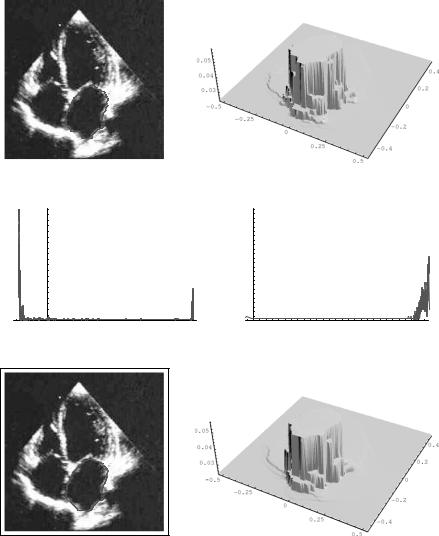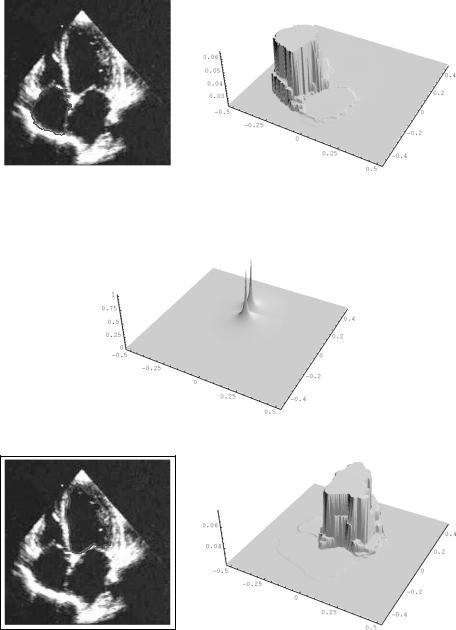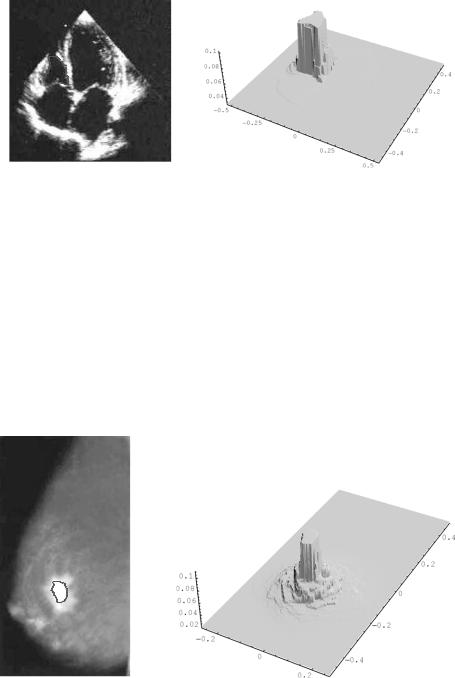
Kluwer - Handbook of Biomedical Image Analysis Vol
.1.pdf


Co-Volume Level Set Method in Subjective Surface |
619 |
||
|
|
|
|
|
|
|
|
Figure 11.27: Segmentation level line and graph of the segmentation function for the right ventricle (color slide).
11.5 Conclusions
In this chapter we introduced the semi-implicit co-volume level set method for solving the segmentation equation given by the Riemannian mean curvature flow of graphs. We discussed basic properties of the model and the role of model parameters and gave all details for computer implementation of the numerical algorithm. We also showed unconditional stability of our method and its high efficiency for this type of problems. The computational results related to
Figure 11.28: Segmentation level line and graph of the segmentation function
for extraction of tumor in mammography (color slide).
620 |
Mikula, Sarti, and Sgallari |
medical image segmentation with partly missing boundaries and subjective contour extraction were discussed. The method was presented for 2D image segmentation. However, as is common in level set methods, the extension to 3D case is straightforward and can be done easily using ideas of this chapter.
11.6 Acknowledgements
This work was supported by NATO Collaborative Linkage Grant No. PST.CLG. 979123. The work of the first author was supported by the grant VEGA 1/0313/03, and by the European project “Visual Modeling” in Stefan Banach International Mathematical Centre PAN and ICM, Warsaw University. This work was partially supported by MIUR, grant number 2002013422-005.
Questions
1.Outline the level set segmentation models used in the last decade. What is an advection–diffusion mechanism in such models?
2.What is the difference between previous level set segmentation models and Riemannian mean curvature flow of graphs discussed in this chapter?
3.What are the main principles and advantages of the semi-implicit time discretization?
4.How is the segmentation partial differential equation (11.2) discretized by the co-volume method?
5.What are the differences between semi-implicit co-volume method and explicit finite difference method?
6.What are the properties of the system matrix given by the semi-implicit co-volume scheme?
7.How can you get unconditional stability of the semi-implicit co-volume level set method?
8.What are the efficient methods for solving linear systems arising in the semi-implicit co-volume level set method?

Co-Volume Level Set Method in Subjective Surface |
621 |
Bibliography
[1]Alvarez, L., Guichard, F., Lions, P.L., and Morel, J.M., Axioms and fundamental equations of image processing, Arch. Rat. Mech. Anal., Vol. 123, pp. 200–257, 1993.
[2]Alvarez, L., Lions, P. L., and Morel, J. M., Image selective smoothing and edge detection by nonlinear diffusion II, SIAM J. Numer. Anal., Vol. 29,
pp.845–866, 1992.
[3]Bansch,¨ E. and Mikula, K., A coarsening finite element strategy in image selective smoothing, Comput. Vis. Sci., Vol. 1, No. 1, pp. 53–61, 1997.
[4]Bansch,¨ E. and Mikula, K., Adaptivity in 3D image processing, Comput. Vis. Sci., Vol. 4, No. 1, pp. 21–30, 2001.
[5]Catte,´ F., Lions, P. L., Morel, J. M., and Coll, T., Image selective smoothing and edge detection by nonlinear diffusion, SIAM J. Numer. Anal., Vol. 29,
pp.182–193, 1992.
[6]Caselles, V., Catte,´ F., Coll, T., and Dibos, F., A geometric model for active contours in image processing, Numer. Math., Vol. 66, pp. 1–31, 1993.
[7]Caselles, V., Kimmel, R., and Sapiro, G., Geodesic active contours, In: Proceedings International Conference on Computer Vision’95, Boston,
pp.694–699, 1995.
[8]Caselles, V., Kimmel, R., and Sapiro, G., Geodesic active contours, Int. J. Comput. Vis., Vol. 22, pp. 61–79, 1997.
[9]Caselles, V., Kimmel, R., Sapiro, G., and Sbert, C., Minimal surfaces: A geometric three dimensional segmentation approach, Numer. Math., Vol. 77, pp. 423–451, 1997.
[10]Chen, Y.-G., Giga, Y., and Goto, S., Uniqueness and existence of viscosity solutions of generalized mean curvature flow equation, J. Diff. Geom., Vol. 33, pp. 749–786, 1991.
[11]Citti, G. and Manfredini, M., Long time behavior of Riemannian mean curvature flow of graphs, J. Math. Anal. Appl., Vol. 273, No. 2, pp. 353– 369, 2002.
622 |
Mikula, Sarti, and Sgallari |
[12]Crandall, M. G., Ishii, H., and Lions, P. L., User’s guide to viscosity solutions of second order partial differential equations, Bull. (NS) Amer. Math. Soc., Vol. 27, pp. 1–67, 1992.
[13]Deckelnick, K. and Dziuk, G., Convergence of a finite element method for non-parametric mean curvature flow, Numer. Math., Vol. 72, pp. 197– 222, 1995.
[14]Deckelnick, K. and Dziuk, G., Error estimates for a semi implicit fully discrete finite element scheme for the mean curvature flow of graphs, Interfaces Free Bound., Vol. 2, No. 4, pp. 341–359, 2000.
[15]Deckelnick, K. and Dziuk, G., A fully discrete numerical scheme for weighted mean curvature flow, Numer. Math., Vol. 91, pp. 423–452, 2002.
[16]Dziuk, G., Algorithm for evolutionary surfaces, Numer. Math., Vol. 58, pp. 603–611, 1991.
[17]Dziuk, G., Convergence of a semi discrete scheme for the curve shortening flow, Math. Models Methods Appl. Sci., Vol. 4, pp. 589–606, 1994.
[18]Dziuk, G., Discrete anisotropic curve shortening flow, SIAM J. Numer. Anal., Vol. 36, pp. 1808–1830, 1999.
[19]Evans, L. C. and Spruck, J., Motion of level sets by mean curvature I, J. Diff. Geom., Vol. 33, pp. 635–681, 1991.
[20]Eymard, R., Gallouet, T., and Herbin, R., The finite volume method, In: Handbook for Numerical Analysis, Vol. 7, Ciarlet, Ph., and Lions, J. L., eds, Elsevier, Amsterdam, 2000.
[21]Frolkovic,ˇ P. and Mikula, K., Flux-based level set method: A finite volume method for evolving interfaces, Preprint IWR/SFB 2003–15, Interdisciplinary Center for Scientific Computing, University of Heidelberg, 2003.
[22]Gage, M. and Hamilton, R. S., The heat equation shrinking convex plane curves, J. Diff. Geom., Vol. 23, pp. 69–96, 1986.
[23]Grayson, M., The heat equation shrinks embedded plane curves to round points, J. Diff. Geom., Vol. 26, pp. 285–314, 1987.
Co-Volume Level Set Method in Subjective Surface |
623 |
[24]Handlovicovˇa,´ A., Mikula, K., and Sarti, A., Numerical solution of parabolic equations related to level set formulation of mean curvature flow, Comput. Vis. Sci., Vol. 1, No. 2, pp. 179–182, 1999.
[25]Handlovicovˇa,´ A., Mikula, K., and Sgallari, F., Semi-implicit complementary volume scheme for solving level set like equations in image processing and curve evolution, Numer. Math., Vol. 93, pp. 675–695, 2003.
[26]Handlovicovˇa,´ A., Mikula, K., and Sgallari, F., Variational numerical methods for solving nonlinear diffusion equations arising in image processing, J. Vis. Commun. Image Represent., Vol. 13, pp. 217–237, 2002.
[27]Kacur,ˇ J. and Mikula, K., Solution of nonlinear diffusion appearing in image smoothing and edge detection, Appl. Numer. Math., Vol. 17, pp. 47–59, 1995.
[28]Kacur,ˇ J. and Mikula, K., Slow and fast diffusion effects in image processing, Comput. Vis. Sci., Vol. 3, No. 4, pp. 185–195, 2001.
[29]Kanizsa, G., Organization in Vision, Praeger, New York, 1979.
[30]Kichenassamy, S., Kumar, A., Olver, P., Tannenbaum, A., and Yezzi, A., Gradient flows and geometric active contours models, In: Proceedings International Conference on Computer Vision’95, Boston, 1995.
[31]Kichenassamy, S., Kumar, A., Olver, P., Tannenbaum, A., and Yezzi, A., Conformal curvature flows: From phase transitions to active vision, Arch. Rat. Mech. Anal., Vol. 134, pp. 275–301, 1996.
[32]Kass, M., Witkin, A., and Terzopulos, D., Snakes: Active contour models, Int. J. Comput. Vis., Vol. 1, pp. 321–331, 1987.
[33]Kriva,´ Z. and Mikula, K., An adaptive finite volume scheme for solving nonlinear diffusion equations in image processing, J. Vis. Commun. Image Represent., Vol. 13, pp. 22–35, 2002.
[34]Le Veque, R., Finite volume methods for hyperbolic problems, Cambridge Texts in Applied Mathematics, Cambridge University Press, Cambridge, 2002.
[35]Lin, C. J. and More,´ J. J., Incomplete Cholesky factorizations with limited memory, SIAM. J. Sci. Comput., Vol. 21, pp. 24–45, 1999.
624 |
Mikula, Sarti, and Sgallari |
[36]Malladi, R., Sethian, J. A., and Vemuri, B., Shape modeling with front propagation: A level set approach, IEEE Trans. Pattern Anal. Mach. Intell., Vol. 17, pp. 158–174, 1995.
[37]Mikula, K. and Ramarosy, N., Semi-implicit finite volume scheme for solving nonlinear diffusion equations in image processing, Numer. Math., Vol. 89, No. 3, pp. 561–590, 2001.
[38]Mikula, K., Sarti, A., and Lamberti, C., Geometrical diffusion in 3D-echocardiography, Proceedings of ALGORITMY’97—Conference on Scientific Computing, West Tatra Mountains, Zuberec, pp. 167–181, 1997.
ˇ
[39] Mikula, K. and Sevcoviˇc,ˇ D., Evolution of plane curves driven by a nonlinear function of curvature and anisotropy, SIAM J. Appl. Math., Vol. 61, pp. 1473–1501, 2001.
ˇ
[40] Mikula, K. and Sevcoviˇc,ˇ D., Computational and qualitative aspects of evolution of curves driven by curvature and external force, Comput. Visual. Sci., Vol. 6, No. 4, pp. 211–225, 2004.
[41] Mikula, K. and Sgallari, F., Semi-implicit finite volume scheme for image processing in 3D cylindrical geometry, J. Comput. Appl. Math., Vol. 161, No. 1, pp. 119–132, 2003.
[42] Osher, S. and Fedkiw, R., Level set methods and dynamic implicit surfaces, Springer-Verlag, Berlin, 2003.
[43] Osher, S. and Sethian, J. A., Front propagating with curvature dependent speed: Algorithms based on the Hamilton–Jacobi formulation, J. Comput. Phys., Vol. 79, pp. 12–49, 1988.
[44] Patankar, S., Numerical heat transfer and fluid flow, Hemisphere Publications, Corporation, New York, 1980.
[45] Perona, P. and Malik, J., Scale space and edge detection using anisotropic diffusion, In: Proc. IEEE Computer Society Workshop on Computer Vision, 1987.
[46] Saad, Y., Iterative methods for sparse linear systems, PWS Publications Company, 1996.
Co-Volume Level Set Method in Subjective Surface |
625 |
[47]Sapiro, G., Geometric Partial Differential Equations and Image Analysis, Cambridge University Press, Cambridge, 2001.
[48]Sarti, A., Malladi, R., and Sethian, J. A., Subjective Surfaces: A Method for Completing Missing Boundaries, Proc. Nat. Acad. Sci. USA, Vol. 12, No. 97, pp. 6258–6263, 2000.
[49]Sarti, A. and Citti, G., Subjective Surfaces and Riemannian Mean Curvature Flow Graphs, Acta Math. Univ. Comenianae, Vol. 70, No. 1,
pp.85–104, 2001.
[50]Sarti, A., Malladi, R., and Sethian, J. A., Subjective Surfaces: A Geometric Model for Boundary Completion, Int. J. Comput. Vis., Vol. 46, No. 3,
pp.201–221, 2002.
[51]Sarti, A., Mikula, K., and Sgallari, F., Nonlinear multiscale analysis of three-dimensional echocardiographic sequences, IEEE Trans. Med. Imaging, Vol. 18, pp. 453–466, 1999.
[52]Sarti, A., Mikula, K., Sgallari, F., and Lamberti, C., Nonlinear multiscale analysis models for filtering of 3D + time biomedical images, In: Geometric Methods in Bio-medical Image Processing, Malladi, R., ed., Springer, Berlin, pp. 107–128, 2002.
[53]Sarti, A., Mikula, K., Sgallari, F., and Lamberti, C., Evolutionary partial differential equations for biomedical image processing, J. Biomed. Inform., Vol. 35, pp. 77–91, 2002.
[54]Sethian, J. A., Numerical algorithm for propagating interfaces: Hamilton–Jacobi equations and conservation laws, J. Diff. Geom., Vol. 31, pp. 131–161, 1990.
[55]Sethian, J. A., Level set methods and fast marching methods. Evolving Interfaces in Computational Geometry, Fluid Mechanics, Computer Vision, and Material Science, Cambridge University Press, Cambridge, 1999.
[56]Walkington, N. J., Algorithms for computing motion by mean curvature, SIAM J. Numer. Anal., Vol. 33, No. 6, pp. 2215–2238, 1996.
626 |
Mikula, Sarti, and Sgallari |
[57]Weickert, J., Anisotropic Diffusion in Computer Vision, TeubnerStuttgart, 1998.
[58]Weickert, J., Romeny, B. M. t. H., and Viergever, M. A., Efficient and reliable schemes for nonlinear diffusion filtering, IEEE Trans. Image Process., Vol. 7, No. 3, pp. 398–410, 1998.
